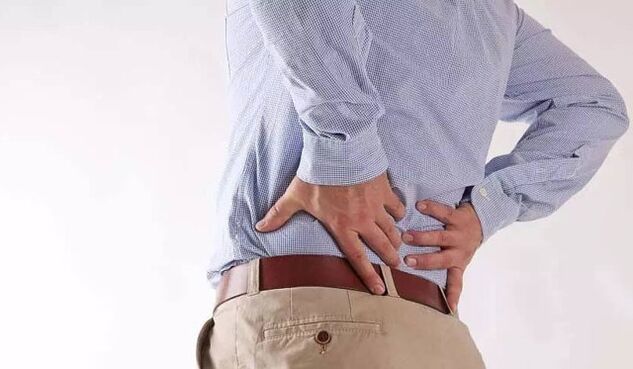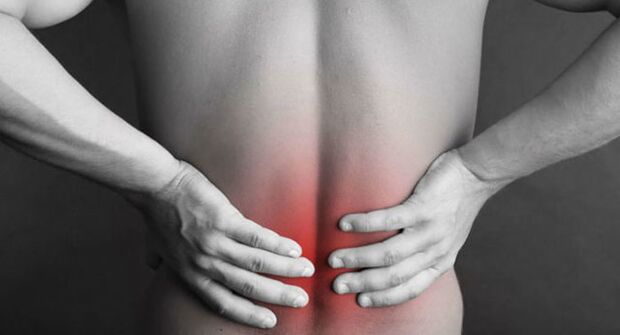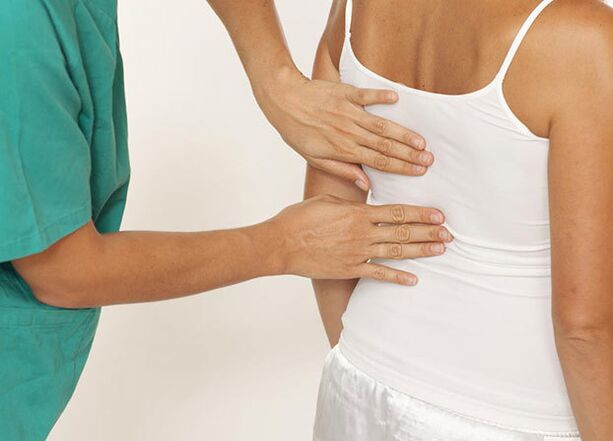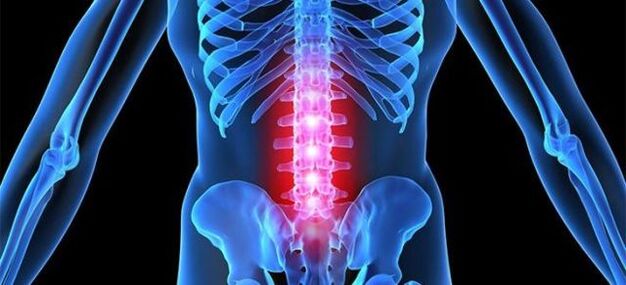People under the age of 55 are approx. 80% experience the manifestations of rear diseases and should not neglect the face of younger age groups. Thus, it is one of the most common diseases of the lumbar spinal spine-aneochondrosis in patients aged 25-45. Even young people aged 16-25 are increasingly suffering from the symptoms and causes of this extremely unpleasant disease. The question becomes logical that we can stop the number of patients in general, and what to do for preventive purposes, so as not to become a victim of this pathology?
Symptoms
Because the disease is inadequate attention, early diagnosis, treatment is difficult as secondary diseases or complications occur. As a natural continuation of pathology, osteochondrosis develops. Treatment is not always effective, and if tightening or improperly prescribed therapeutic path, the risk of disability occurs. Another typical problem is the appearance of intervertebral hernia, accompanied by unbearable painful feelings. Every day, there will be less and less chance of getting rid of the hernia irrevocably.
Typical clinical symptoms promote the detection of the disease early and avoid these sad consequences:
- Sharp pain after night's sleep;
- Pain with the sharp spread of the body or the item of difficult things;
- The body becomes inactive;
- Signs of skoliosis appear;
- The dream becomes restless;
- Depressed moods arise;
- Frequent urination is observed.
Independent assessment of these symptoms cannot be correct, as most of them show frequent similarities with signs of other diseases of the spine or joints. Therefore, only a rheumatologist or orthopedic has a competence to talk about the presence of developing osteochondrosis of the lumbar region.
Classification
Differential diagnosis to correctly determine and distinguish the disease from the same pathologies and determine the treatment course, classification of the stages of the disease helps:
- Stage 1 - At this time, the cartilage structure is just beginning to change. But now the pathological processes are influenced by the roots of nerve endings. As a result, they cause pain in the legs. At the same time, blood flow deteriorates and inflammation is caused. The pains are acute or stupid, and mainly only after reinforced loads on the back axis;
- Section 2 begins with the destruction of the fibrous ring in the spine, while the cartilage is thinner, and the vertebrae reduce the distance. In the second stage, the pain is sharp and sharp, sometimes unreasonable. During this period, the mobility of the spine increases throughout the axis, nerves lace, exert pressure on the soft tissues of the muscle linen;
- Stage 3 is characterized by strong compression of muscle fibers and nerve roots. Inexhaustible cramps and pain with the burning character. In the area of defeat, the numbness feels. With the intense development of the disease, signs of parasis and paralysis appear;
- Stage 4 - Growth period of already formed osteophytes (tumors with bone structure). At this stage, changes in degenerative nature are activated, with the appearance of arthrosis of the spine and joints. The back becomes inactive and, in the absence of proper treatment - completely motionless.
Diagnostic methods
Because even the ideal knowledge of the clinic and the classification of lumbar spine osteochondrosis does not give a complete picture of the pathological processes it provokes, the doctor who deals with the treatment of pathological processes in the spine should be prescribed further diagnostic examination : : : : : : : :
- X -gray in the front and side projection - allows the identification of the axis of the axis, the formation of osteophytes, and the anatomical disorders of the vertebrae;
- Magnetic resonance imaging determines the condition of the entire zone of back damage, detecting the fragments of the destroyed vertebrae, cartilage and inflammation;
- Computer tomography gives an image of the outer shells of soft tissues, vertebrae bones, the intervertebral disk, in principle, which is supposed to integrity. and blood circulation in the area of the disease.

At the same time, the patient performs tests for a rheumatoid test, general blood indicators, and biochemical components. Full survey results allow an accurate diagnosis and identification of osteochondrosis of the lumbar region.
Symptoms and treatment of osteochondrosis of the lumbar spine
Frequent causes of pain in the back of the back are osteochondrosis of the lumbar spine, the symptoms of which are characterized by characteristics. The disease is the initial stage of osteochondrosis associated with the process of destroying the cartilage, the height of the reduction, the formation of swelling and the lace of the nerve roots. Young and old people can face the disease, gender, social status and religion. A long deficiency of the symptoms of the disease leads to the loss of valuable time and the transition from one stage of the disease to more severe forms of development. The main distinctive feature of osteochondrosis in the tissues of the vertebrae is the boundary zone of dystrophic changes, which does not exceed the joint cartilage.
Causes of the initial stages of osteochondrosis
Many external and internal factors determine the abnormal condition of the axial skeleton condition of the axial skeleton. Lumbar osteochondrosis is due to certain risk factors. They belong to:
- body aging after 50 years;
- an anatomical structure of the axial skeleton, which determines the uneven load of the vertebrae;
- raising weight with a weak muscle frame;
- The patient's body and the lower back separately -special hypothermia;
- Dysfunction of metabolic processes, work of endocrine organs, cardiovascular system;
- Uneven spine during production tasks, housework, professional and amateur sports;
- Pathologies of a congenital or acquired muscle bone system;
- Hypodynamia, high frequency of stressful situations;
- excess weight of the patient;
- Lack of vitamins, minerals, trace elements in a sick man's body that are responsible for the health of the spine;
- Acquiring tall chaplain, uncomfortable platforms;
- Using tall pillows and soft mattresses while relaxing and sleeping.
The frequency of diagnosis of osteochondrosis of the lumbar skeleton is determined by the number of risk factors present in the patient's life.
Diagnosis of the disease
Determination of degenerative-dynist lesion of the Altophical lesion of the axial skeleton provides diagnostic measures. A doctor prescribes them. During a consultation with professionals, who knows how to treat lumbar osteochondrosis, the disease history, the time and characteristics of signs, and the intensity and location of the localization of painful feelings. The condition of the muscle fibers in the injury zone is determined by a visual examination. Using the tactile method allows the doctor to see a picture of the symmetry of the vertebrae and the distance between them. The final diagnosis is determined after the results of complementary tests have been obtained. They belong to:
- X -Ray, performed with two projections, and provides an opportunity to see the position of the vertebrae, the height of the plates, the seal of marginal bone plates and growth;
- Magnetic resonance imaging, which is a special research method to determine the condition of the vascular and fibrous rings in the degenerative-dynish lesion zone.
Objectives and methods of treating pathology
The results of diagnostic measures are the treatment of osteochondrosis of the lumbar lumbar skeleton, which achieves certain objectives. They belong to:
- decrease in pain intensity caused by degenerative-dyclic injuries to one or more vertebrae of the lumbar skeleton;
- Normalization of metabolic processes in cartilage, excluding the risk of restoration and further destruction;
- reducing the load on nerve fibers;
- Increased blood flow to the spine of massage with physiotherapy;
- Strengthening the muscle frame of the axial skeleton with regular exercise exercises recommended by the instructor.
Therapy for chondrosis of the lumbar spine, which has symptoms and treatment of its own characteristics, contains medication and use, recipes for conventional medicine, unusual treatment methods, including hirudotherapy. Effective complement to a pathology problem is physiotherapy, water, massage procedures, gymnastics and sports, including special exercises. Medication includes the use of anti -inflammatory drugs, muscle relaxants, chondroprotectors, vitamin complexes with trace elements and minerals.
Very severe pains are used to prescribe novocaine or lidocaine blockades, which are carried out by introducing injections into the affected areas of the vertebrae. For local use, ointments, gels, creams, heating, anti -inflammatory effects require repairs. Physiotherapeutic treatment includes the passage of electrophoresis, diadynamic healing course, and exposure to ultraviolet, manual, shock and reflexological procedures. In the absence of positive dynamics, the appearance of hernial protrusions require surgical operation. Treatment should begin immediately to avoid complications with the onset of the first symptoms.
Osteochondrosis
Lumbar osteochondrosis is one of the most common forms of the disease that is based, in fact osteochondrosis. Lumbar osteochondrosis, whose symptoms are determined by both men and women, are manifested in the form of pain in the sacrum, and are reflected in their symptoms and on the lower limbs, which are often determined by patients to "tighten lumbar nerves".
Prominence to lumbar osteochondrosis
In this area, the interests that are of interest are most often developed, and protrudes cause pain in the lower back. The lumbar region itself, given its location and characteristics, corresponds to the development of certain functional problems. That is, if this statement is taken into account on the one hand, it can be distinguished that our center of gravity refers directly to the lumbar class, precisely on it, a significant part of the loading invoices. On the other hand, it can be noted that the significant amplitude of movements is again on this lumbar region. Nevertheless, the largest trend of damage (and the prominence of interest) is on concentrated discs in the lumbar region. In addition, we must not forget that changes in discs in other areas, including age -related degenerative processes, and of course in other areas.
Remember our readers what the outstanding is themselves. The discs in the spine are provided by the wheels based on the cartilage. The main components of the intervertebral plate are a pier and a fibrous ring through which the fixation is fixed within the spine. The effect of certain factors and conditions provokes the possibility of interruption of the ring, the background of which is the prominence of the core. As a result of this process, the hernia develops. As far as protrusion is concerned, it develops as a result of a similar process of the process, but without the simultaneous break of the ring - in this case it is simply exposed to thinning and not a break because the seeds extend directly through the ring. In fact, this protrusion is considered to be a protrusion.
As for the symptoms of prominence, it is manifested as follows:
- feeling of stiffness in the lower part;
- pain in the lumbar region;
- Lower chronic pain;
- lumbosacral radiculite;
- numbness, pain, tingling of fingers on the legs;
- Damaged urinary functions (in rare cases of examined pathology).

Conservative treatment is most used to protrude the lumbar disc. Meanwhile, there are significant significant symptoms in the development of protrusion, resistant to treatment, in which case they are no longer known without surgical intervention.
Treatment
Mostly treatment for osteochondrosis is multi -component and quite complex in its implementation. Mostly the degree of all therapy is reduced to the following points:
- drug treatment;
- If necessary - surgical treatment;
- diet;
- Medical physical education.
Above all, the illness of the disease requires patients to meet bed rest. The main recommendation of the part is a hard/hard sleeping place. Extremely expressed in manifestations, attacks ensure the need for minimal engine load and the early relationship of the competent specialist.






















